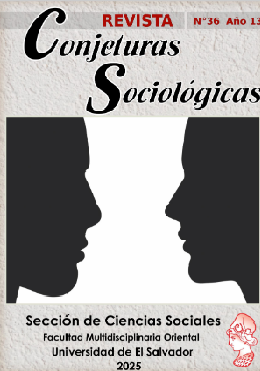Violencia en la formación del Estado salvadoreño en el siglo XX
Keywords:
Nation state, social structure, history, political power, economic systemAbstract
The essay examines the role of state violence in the construction of the Salvadoran State throughout the 20th century, highlighting how military and authoritarian governments used coercion and repression to maintain political control. For the analysis, three specific cases are taken: the indigenous massacre of 1932, the massacre of students at the University of El Salvador in 1975, and the El Mozote massacre in 1981. It is highlighted that state violence was a key tool used by all governments to consolidate the power of economic and political elites, revealing not only the legitimate use of the monopoly of violence by the State to achieve its ends, but also the very nature of the regimes that sought to favor the concentration of power and social exclusion. Throughout history, repression was directed at the population, but mainly at those who opposed the dominant structure, including indigenous people, students and peasants, with the aim of eliminating any threat to the established order. The article argues that state violence was a means to impose political and social order and control over the population, as well as to impose and safeguard the power of the elites, guaranteeing the stability of an economic system that favored a few to the detriment of the majority and deepening social inequalities. This analysis allows us to understand the interrelationship between violence, power and the State, demonstrating how repression has been a constant in Salvadoran political history and in the construction of the national State.
Downloads
References
Argueta, R. (2022). La construcción de las memorias y los héroes salvadoreños en el siglo XX: El caso de los estudiantes universitarios y los militares. En De[s]marcaciones. Aportes científicos de la Facultad de Ciencias y Humanidades. Instituto de Investigaciones de la Facultad de Ciencias y Humanidades .
Bengoa Valdés, A. J., & Villavicencio Rodríguez, E. (2013). Políticas de la violencia estatal: Los casos de Colombia y El Salvador. https://biblioteca-repositorio.clacso.edu.ar/handle/CLACSO/10811
Bolívar, I. J. (1999). Sociedad y Estado: La configuración del monopolio de la violencia. REVISTA CONTROVERSIA, 175, Article 175.
Cruz, J. M. (1997). Los factores posibilitadores y las expresiones de la violencia en los noventa. ECA: Estudios Centroamericanos, 52(588), 977-992.
González, Á. A. (2022). El dualismo analítico agente/estructura y las relaciones entre economía y política en El Salvador. ECA: Estudios Centroamericanos, 77(769), Article 769. https://doi.org/10.51378/eca.v77i769.7052
Hernández, E. (2016). La masacre estudiantil del 30 de julio de 1975. La Universidad, 9(30), Article 30. https://revistas.ues.edu.sv/index.php/launiversidad/article/view/748
López Bernal, C. G. (2015). El Salvador: Historia Contemporánea, 1808-2010. Universidad de El Salvador.
Molinari, L. (2023). La “matanza” de 1932 en El Salvador: Prácticas sociales genocidas y sus representaciones sociales. Question/Cuestión, 3(74), Article 74. https://doi.org/10.24215/16696581e787
Montoya, C., & Edgardo, J. (2012). “Un largo y penoso proceso”: Severo Martínez Peláez y la Historia social sobre la Independencia de Centroamérica. Bajo El Volcán, 12(19), Article 19.
Neocleous, M. (2014). War power, police power. Edinburgh University Press.
Núñez, M. Z. (2023). “Estudiantes como sombras del futuro”: Las voces de las víctimas de la masacre del 30 de julio de 1975 en las memorias públicas de la Universidad de El Salvador. Revista de Filosofía de la Universidad de Costa Rica, 62(163), Article 163. https://doi.org/10.15517/revfil.2023.55102
O’Donnell, G. (1978). Apuntes para una teoría del Estado. Revista Mexicana de Sociología, 40(4), 1157-1199. https://doi.org/10.2307/3539655
Paley, D. (2014). Drug war capitalism. AK Press.
Pearce, J. (2020). Politics without Violence?: Towards a Post-Weberian Enlightenment. Springer International Publishing. https://doi.org/10.1007/978-3-030-26082-8
Pérez-Sales, P., & García, S. N. (2007). Resistencias contra el olvido: Trabajo psicosocial en procesos de exhumaciones. Editorial GEDISA.
Romero Herrera, J. (2010). Violencia, autonomía militar y procesos de formación del Estado y la constitución de la Nación. Revista Criminalidad, 52(2), 113-131.
Rostica, J., Kovalskis, M., Molinari, L., & Molina, M. O. (2020). La masacre de El Mozote en El Salvador: Una aproximación a la responsabilidad argentina. e-l@tina. Revista electrónica de estudios latinoamericanos, 18(71), Article 71. https://publicaciones.sociales.uba.ar/index.php/elatina/article/view/5359
Salgado, M. (2011). Factores clave para entender la violencia en El Salvador. ECA: Estudios Centroamericanos, 66(725), Article 725. https://doi.org/10.51378/eca.v66i725.3427
Comisión de la Verdad para El Salvador, Betancur, B., Figueredo Planchart, R., & Buergenthal, T. (1993). . De la locura a la esperanza. La guerra de 12 años en El Salvador. Informe de la Comisión de la Verdad para El Salvador. https://repositorio.iidh.ed.cr/handle/123456789/1971
Downloads
Published
Issue
Section
License

This work is licensed under a Creative Commons Attribution-NonCommercial 4.0 International License.
Los autores continúan como propietarios de sus trabajos, cediendo de manera no exclusiva los derechos de difusión a la Revista Conjeturas Sociológicas bajo los estándares de la Licencia Creative Commons Atribución No Comercial 4.0 Internacional (CC BY NC 4.0).





